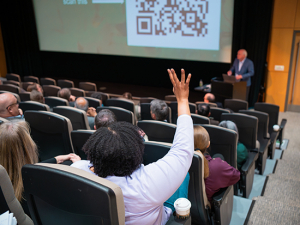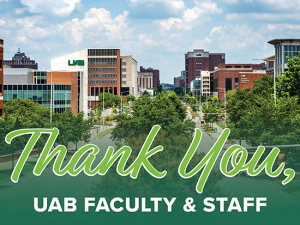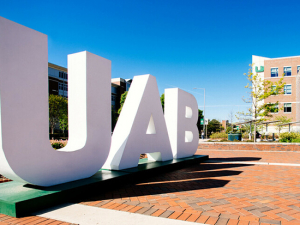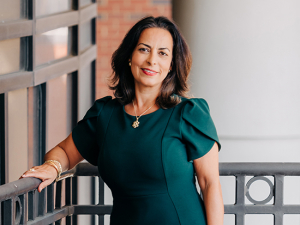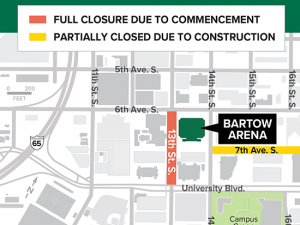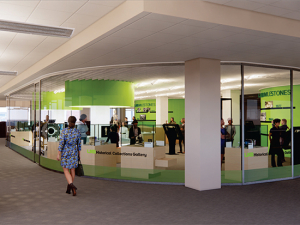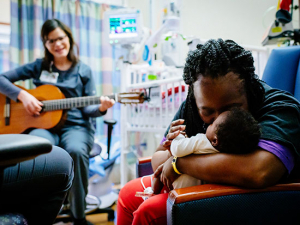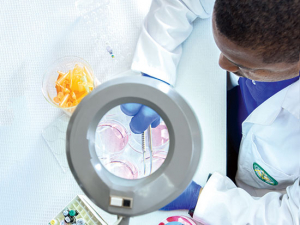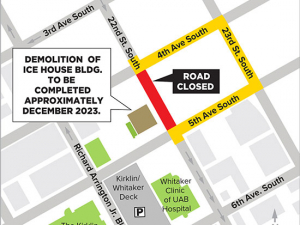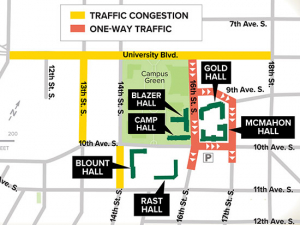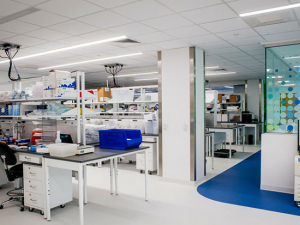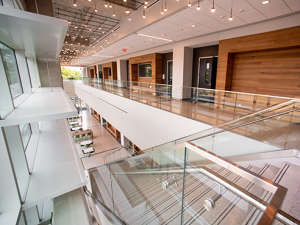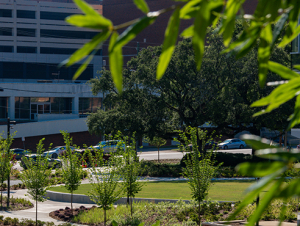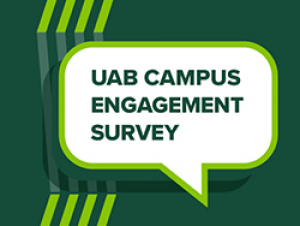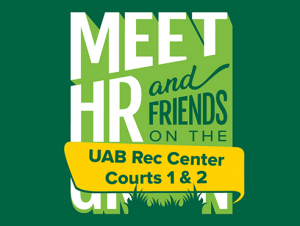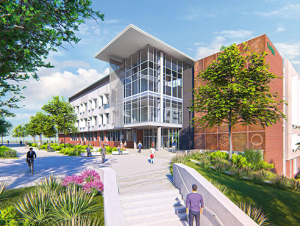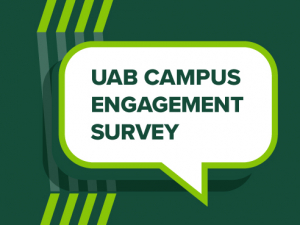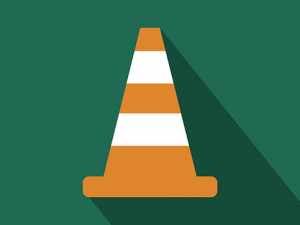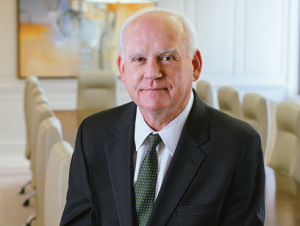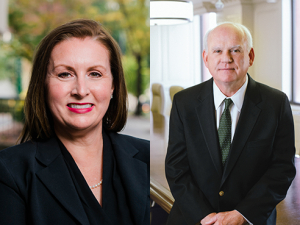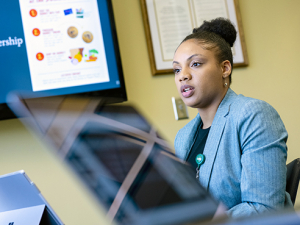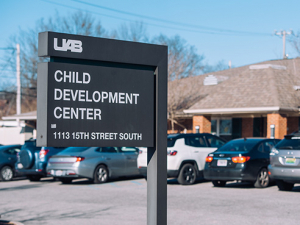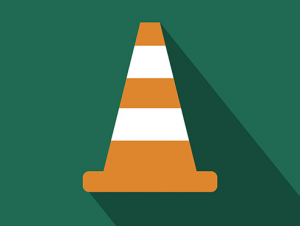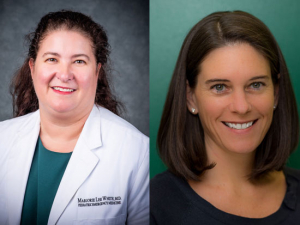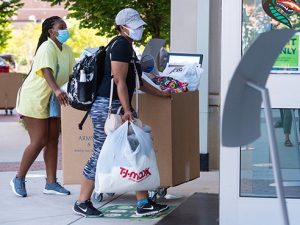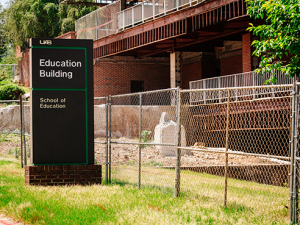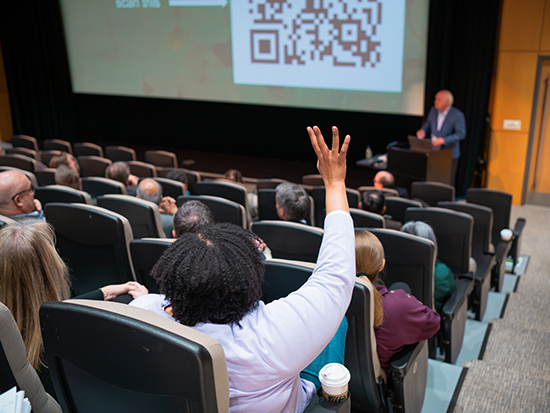 Photo by JENNIFER ALSABROOK-TURNER | Creative and Marketing
Photo by JENNIFER ALSABROOK-TURNER | Creative and Marketing
During a town hall meeting March 20, UAB senior leaders explained how the university will move forward with its Research Strategic Initiative: Growth with Purpose. President Ray Watts, M.D., and Chris Brown, Ph.D., UAB’s vice president for Research, along with Huron Consulting Group managing partner Eric Tomasini, outlined the planning that has begun to shape the new initiative, opportunities and challenges identified by the UAB research community, the initiative’s goals and objectives, high-growth research areas, governance structure, and key priorities for immediate action.
A video of the meeting is now posted online, and all members of the UAB community are encouraged to give their feedback on the plan here.
Scroll down to read a summary of the town hall, or use the links to jump to specific points in the discussion:
- Origins of the initiative
- Engaging external consultants
- Stakeholder interviews
- External market analysis
- UAB Research Design Working Group and detailed report
- Infrastructure “enablers”
- Research strategic goals
- High-growth research areas
- Proposed structure to review and attain research goals and objectives
- Financial considerations
Process
Origins of the initiative
President Watts began by outlining the origins of the initiative, which began about a year ago. UAB has doubled its research funding over the past 10 years, and it was clear that continued growth at that level would enable the university to reach $1 billion within five to seven years — a level that only 29 institutions have reached, Dr. Watts said. “It’s not just about the money; it is really about the impact,” he added, the impact that can be made when faculty can thrive and contribute meaningfully to their fields and research administrators are provided the resources needed to effectively and efficiently support them.
Engaging external consultants
UAB engaged Huron Consulting Group and Urban Impact Advisors to evaluate its research infrastructure, identify strategic opportunity areas to structure research growth and impact society, and identify growth areas to expand clinical trials. “We said, ‘Let’s look at our talent, our processes, our technology, our space and equipment, and lay the foundation for this growth over the coming five to seven years,’” Dr. Watts said.
Watch President Watts discuss the origins of the Research Strategic Initiative here.
Stakeholder interviews
In an intensive six-month engagement from July through December 2023, the external consultants conducted more than 120 interviews with stakeholders across campus, reviewed 575 survey responses and analyzed 54 million health claims from UAB patients to identify the major opportunities and challenges around continued research growth. “They showed us where we are strongest and where our funding comes from,” Dr. Watts said.
The consulting team, noted Huron’s Eric Tomasini, “really wanted to know what was on the minds of faculty” in terms of areas of interest and the opportunities and challenges around infrastructure needed to continue UAB’s research funding momentum.
External market analysis
Huron also conducted an external market analysis, including an in-depth look at the federal funding landscape and the growth narratives of benchmarking institutions — from UCLA and the University of Florida to the University of Pittsburgh and UC San Diego — with between $500 million and $1 billion-plus in research funding. “What we saw from those organizations was deep funding from the Department of Defense, the National Science Foundation, the Department of Energy, and Health and Human Services,” Mr. Tomasini said. In order to sustain UAB’s growth, he said, “there will definitely need to be diversification” beyond UAB’s core strength in NIH funding. Huron also analyzed “how these organizations are structured” in terms of supporting research through centralized infrastructure, Mr. Tomasini said.
Watch Mr. Tomasini discuss the stakeholder interviews and external market analysis here.
UAB Research Design Working Group and detailed report
At the same time, Dr. Watts convened a group of 16 key leaders at UAB as the Research Design Working Group (see membership here). This strategic decision-making body provided guidance and oversight. The detailed report provided to the group by the consulting team included:
- focus areas identified by the UAB research community;
- challenges and opportunities identified by the research community across five themes:
- research culture and governance,
- organizational effectiveness,
- processes,
- space and equipment, and
- technology; and
- key takeaways from the benchmarking institutions across three themes:
- lessons learned,
- research growth strategies, and
- capabilities and infrastructure.
Watch Mr. Tomasini discuss focus areas identified by the UAB community, challenges/opportunities, and key takeaways from benchmarking institutions here.
Paths to growth
Infrastructure "enablers"
Dr. Brown discussed the six infrastructure opportunities, or “enablers,” that are essential to support the institution’s research growth and the five research strategic goals and objectives that have been identified by the Research Design Working Group.
Six “enablers-infrastructure opportunities” will be needed to support the research strategic growth, Dr. Brown said:
- Optimize research-related processes.
- Invest in innovative, enterprise-wide technology solutions.
- Enhance research data management and structure.
- Become the employment destination for research staff.
- Augment and elevate the research workforce.
- Optimize and enhance current research facilities.
Watch Dr. Brown discuss the enablers here.
Next step: “We will be chartering and forming working groups to look at these six enablers,” consisting of faculty and staff stakeholders from across the institution with expertise in these areas, Dr. Brown explained. Their charge will be to review recommendations and formulate plans to make improvements and report to an executive steering committee chaired by President Watts with Dr. Brown as vice chair.
Proposed working groups structure for enablers
Working Group 1: Research-Related Processes
- Clinical trials – Are we running these efficiently and administering them effectively?
- Grants and contracts – Are we moving those forward with speed and efficiency?
- Other Research offices (IRB, OSP, etc.)
Working Group 2: Research Technology
- Electronic Research Administration tool (currently IRAP)
- OnCore
- Data integration tools
Working Group 3: Research Data Management
- High-performance computing
- Data quality
Working Group 4: Employment Destination
- Hiring policies and practices
- Training resources
Working Group 5: Research Administration Workforce
- Assess organization and staffing levels
Working Group 6: Facilities Optimization and Enhancement
- Space allocation best practices
- Core facilities and equipment
“When the working groups are formed, they will look at this chart and [can] say, ‘We need another subcommittee’ or ‘We can combine these,’” Dr. Brown said. “We need the experts on campus to really move these forward and report back up to the executive steering team periodically on their efforts.”
Watch Dr. Brown discuss the working groups’ structure and duties here.
The research strategic goals:
- Strengthen investigator retention, recruitment and development. “This is a real investment in faculty, in their research and scholarship,” Dr. Brown said.
- Enrich research experiences for students and trainees. “This is key for our university to grow,” Dr. Brown said. “It’s an important recruitment tool, not only for the students, but also for the faculty.”
- Accelerate innovation impact. “This is in terms of inventions and startups and accelerators and incubators,” Dr. Brown said, “including the recruitment of academic entrepreneurs … those people who want to be in the academic world but also potentially spin out a company or create a product.”
- Improve the health of our community. “This is in our DNA and always has been,” Dr. Brown said, “but in particular [we will] look at research that really moves the access to clinical trials forward.”
- Expand interdisciplinary research. “The real movement in science and research is in interdisciplinary work,” Dr. Brown said. “We need to expand our interdisciplinary work and create the opportunities for that to flourish.”
Next step: Research leaders (deans, associate deans, chairs and directors) will develop action plans to achieve these goals and objectives relevant to their units. When appropriate, action steps should focus on the recommended high-growth research areas.
Watch Dr. Brown discuss the research strategic goals here.
High-Growth Research Areas
Five high-growth research areas were identified by Huron and the UAB Research Design Working Group based on the market analysis of UAB’s “strengths and nascent strengths,” Dr. Brown said. “We determined this is where we can make some real headway.”
- Emerging technology and products. “These are cutting-edge technologies, whether that’s bioinformatics and genomics or products in the materials sciences,” Dr. Brown said.
- Social determinants of health. “We know we are strong in social determinants of health,” Dr. Brown said. “This is a critical need for Alabama and the nation in terms of public health, health equity, behavioral health, psychological health — these are areas where we are strong and where there are going to be funding and opportunities to move this forward.”
- Implementation science. “This is where the rubber meets the road,” Dr. Brown said. “We do health system research and find out how we can improve the processes and then bring those into effect.”
- Intersection of clinical trials and precision health. “We talk about this quite a bit, working with our partners at Southern Research in terms of increasing access and personalizing the opportunities,” Dr. Brown said. “We want to get more people involved across the state so that we are serving our citizens better.”
- Health sciences. “We are a health sciences-forward institution. And so we need to continue … particularly in areas of cancer and metabolic disorders and neurosciences,” Dr. Brown said.
An important point to mention, Dr. Brown added, is that the absence of an area on the list does not preclude faculty’s engaging in that research.
Watch Dr. Brown discuss the high-growth research areas here.
Proposed structure to review and attain research goals and objectives
Deans, associate deans for Research, and chairs from each of UAB’s schools and colleges will review the detailed report and “determine how you and your school can move that forward,” Dr. Brown said. As a Dean’s Council, they will then report back through Dr. Brown to President Watts and the executive team periodically, including a retreat to discuss how each school will move forward and how they can collaborate more frequently.
Watch Dr. Brown discuss the Dean’s Council structure here.
Financial considerations
- Faculty investments. “The key to our growth is an investment in our faculty going forward,” Dr. Brown said. “This is in terms of retention … and in terms of recruitment and startup.” Over the next five to seven years, “we anticipate… that we will add faculty across the entire university, and not in an insignificant way,” Dr. Brown said. This will include individual hires, cluster hires and multi-school hires as well, he added.
- Research infrastructure investments. “This includes both personnel and technologies,” Dr. Brown said. This does not mean that “we are going to load up with a lot of administrators in the Office of Sponsored Programs or IRB or anywhere else in my office,” he said. “But over time, if we grow as much as we want to and will, we are going to need the support underneath it.”
Watch Dr. Brown discuss financial considerations here.
Looking ahead
Dr. Brown listed five key priorities for immediate action:
- A new Electronic Research Administration system. Two qualified vendors submitted responses to the Request for Information for a new eRA, Dr. Brown said. Currently, demos from those vendors, Cayuse and Huron Services Group (a division separate from the Huron Consulting Group), are in progress. Visit the Project eRA page on the Office of Research website to learn more, see demos and try out “sandbox” versions of the systems.
- The governance structure (steering committee, working groups, charters) is being developed.
- Clinical Trial Management System. A clinical trials dashboard has been created and work is ongoing to optimize the Clinical Trials Management System and streamline contracting.
- Assistant Vice President for Clinical Trials Operations. This position has been posted, and the role is expected to be filled in early May.
- NSF HERD survey. The survey has been submitted; UAB’s FY 2023 research expenditures were $780 million, a 9.4 percent increase over the FY 2022 total of $713 million.
Next steps
- Working groups will convene to review and finalize recommended action steps.
- Deans, associate deans and chairs will review goals and objectives relevant to their areas and plan measurable action steps to accomplish them.
Periodic updates will be shared through such communication channels as Research Matters, the Research Strategic Initiative: Growth with Purpose website, the eReporter and scheduled meetings.
Providing feedback
The UAB community is encouraged to provide feedback and comments on the presentation and proposed plan.
Watch Dr. Brown discuss next steps here.
Questions
Q: The five high-priority areas – Are those ranked in any way in terms of what is most critical?
President Watts: “No, they are not ranked …. They are all identified as high-priority areas and areas of opportunity. The good thing is we have a lot of strength across many disciplines …. Really, it’s about growing across the board. But no institution can be all things and be the best in everything. But we want to continue to be excellent across the board and be the best in some areas so that we can outcompete others for the funding that is available.”
Q: The structure for next steps is driven very strongly by the academic school structure. How are we going to integrate the units that are not directly within the academic structure, like finance, compliance and legal?
Dr. Brown: “The org charts [the working groups and Dean’s Council slides shown] were not meant to be separated and not talk to each other. The Dean’s Council can call on anybody, and the working groups will include faculty.”
Q: What do you feel are the biggest threats to the success [of this initiative], and how can we, as the research community, be called upon to minimize those threats?
President Watts: “Well, I think one external threat right now is the federal government with the funding of the NIH and NSF and DOD and others purported to be flat or down slightly, and so that bothers us. Chris [Brown] and I are going to Washington in early May to meet with our representatives and senators and advocate .... As you know, Senator Shelby was a great supporter of research funding, and the research funding for the NIH last year was $48.5 billion. I remember when I became president and went to Washington 11 years ago, we were at about $31 [billion] or $32 billion. And my number one priority every time I went was to meet with Senator Shelby and others and say, ‘We need to increase research funding. It is so important to the people of Alabama and our nation and really the world, because we lead the world in biomedical research.’”
Dr. Brown: “One other threat that I can think of, but I’m going to call it an opportunity, is the thought of making this place an employment destination for research. We need to make sure that we are the organization where people want to come to work, at any level. And that includes faculty at the highest level to the research administration staff and everybody else .... We have looked at the reality of funding and salaries and levels of research support staff, for example. And we know that that’s constantly a challenge. And we’ve worked with HR and said we need to be flexible. And we have to continue and enhance rigorous research training for new investigators, for emerging investigators, for our research administration staff, our clinical research nurses and so on.”
